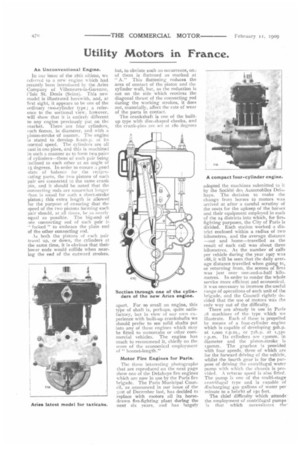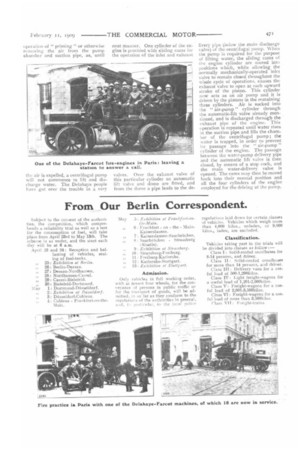Utility Motors in France.
Page 14

Page 15

If you've noticed an error in this article please click here to report it so we can fix it.
An Unconventional Engine.
In our issue of the 28th ultimo, we referred to a new engine which had recently been introduced by the Aries Company of Villeneuve-la-Garenne, l'Isle St Denis (Seine). This new model is illustrated herewith, and, at first sight, it appears to be one of the ordinary two-cylinder type ; a reference to the sectional view, however, will show that it is entirely different to any engine previously put on the market. There are four cylinders, each 6omm. in diameter, and with a piston-stroke of 700mm. The engine is stated to develop 8-7oh.p. at its normal speed. The cylinders are all cast in one piece, and this is machined in such a manner as to form two pairs of cylinders—those of each pair being inclined to each other at an angle of 75 degrees. In order to ensure a good state of balance for the reciprocating parts, the two pistons of each pair are connected to the same crank pin, and it should be noted that the connecting rods are somewhat longer than is usual for such a short-stroke piston ; this extra length is allowed for the purpose of ensuring that the speed of the two pistons forming each pair should, at all times, be as nearly equal as possible. The big-end of one connecting rod of each pair is " forked " to embrace the plain end of the other connecting rod.
As both the pistons of each pair travel up, or down, the cylinders at the same time, it is obvious that their lower ends would collide when nearing the end of the outward strokes.
but, to obviate such an occurrence, on of them is flattened as marked at "A." This flattening reduces the area of contact of the piston and the cylinder wall, but, as the reduction is not on the side which receives the diagonal thrust of the connecting rod during the working strokes, it does not, materially, affect the rate of wear of the parts in contact.
The crankshaft is one of the builtup type with disc-shaped cheeks, and the crank-pins are set at r8o degrees apart. For so small an engine, this type of shaft is, perhaps, quite satisfactory, but in view of our own experience with built-up crankshafts we should prefer to see solid shafts put into any of these engines which may be fitted to motorcabs or other commercial vehicles. The engine has much to recommend it, chiefly on the score of the economical employment of" bonnet-length."
Motor Fire Engines for Paris.
The three interesting photographs that are reproduced on the next page show one of the Delahaye fire engines which are now in use by the Paris fire brigade. The Paris Municipal Council, as announced in our issue of the 3ist of December last, has decided to replace with motors all its horsedrawn fire-fighting plant during the next six years, and has largely
adopted the machines submitted to it by the Societe des Automobiles Delahaye. The decision to make the change from horses to motors was arrived at after a careful scrutiny of the costs for the upkeep of the horses and their equipment employed in each of the 24 districts into which, for firefighting purposes, the City of Paris is divided. Each station worked a district enclosed within a radius of two kilometres, and the average distance —out and home—travelled as the result of each call was about three kilometres. As the number of calls per vehicle during the year 1907 was 188, it will be seen that the daily average distance travelled when going to, or returning from, the scenes of fires was just over one-and-a-half kilometres. In order to render the whole service more efficient and economical, it was necessary to increase the useful range of operations of each unit of the brigade, and the Council rightly decided that the use of motors was the only way out of the difficulty.
There are already in use in Paris IS machines of the type which we illustrate. Each of these is propelled by means of a four-cylinder engine which is capable of developing soh.p. at 7,000 r.p.m., or 72h.p. at 1,350 r.p.m. Its cylinders are 73omm. in diameter and the piston-stroke is 75omm. The gearbox is provided with four speeds, three of which are for the forward driving of the vehicle, whilst the fourth gear is for the purpose of driving the centrifugal water pump with which the chassis is provided. A reVerse speed is also fitted. The pump is one of the multi-stage centrifugal type and is capable of discharging 450 gallons of water per minute to a height of 75o feet.
The Chief difficulty which attends. the employment of centrifugal pumps is that which necessitates the'
operation of " priming " or otherwise removing, the air from the pump chamber and suction pipe, as, until
the air is expelled, a centrifugal pump will not commence to lift and discharge water. The Delahaye people have got over the trouble in a very neat manner. One cylinder of the engine is provided with sliding cams for the operation of the inlet and exhaust valves. Over the exhaust valve of this particular cylinder an automatic lift valve and dome are fitted, and from the dome a pipe leads to the de
livery pipe (below the main discharge valve) of the centrifugal pump. When the pump is required for the purpose of lifting water, the sliding cams of be engine cylinder arc moved into positions which, while allowing the normally mechanically-operated inlet valve to remain closed throughout the whole cycle of operations, causes the exhaust valve to open at each upward stroke of the piston. This cylinder now acts as an air pump and it is driven by the pistons in the remaining three cylinders. Air is sucked into the " air-pump " cylinder through the automatic-lift valve already mentioned, and is discharged through the exhaust pipe of the engine. This operation is repeated until water rises ;Al the suction pipe and fills the charnher of the centrifugal pump ; the water is trapped, in order to prevent its passage into the " air-pump " cylinder of the engine. The passage between the water-pump delivery pipe and the automatic lift valve is then closed, by means of a stop cock, and the main water-delivery valve is opened. The cams may then be moved back into their normal position and all the four cylinders of the engine employed for the driving of the pump.






















